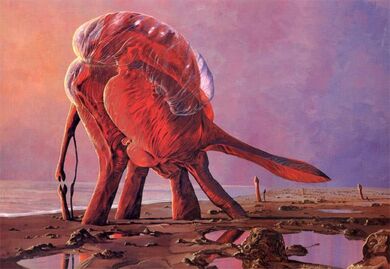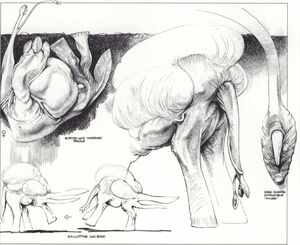
"Here was a rare moment of tenderness on a world where fierceness seemed the rule."
The sac-back is a strange, bulky, red tripedalien from the littoral zone around the Amoebic Sea on Darwin IV. It was first discovered along the southern edge of the "sea," close to the middle of Barlowe's stay on the planet during the First Darwinian Expedition, in 2359, the day before he met the Emperor Sea Striders. It is one of the few notable exceptions of Darwin IV creatures to not be hermaphroditic. They also have one of the more bizarre procreation rituals on the planet.
Protruding from the level surface of a beach near the Amoebic Sea will be groups of half a dozen budlike forms. They are meter-high, semi-rigid stalks surmounted by horny, beaklike "mouths," each of which open at regular intervals to exhale a cloud of steamy air. Adjacent to each stalk is a thinner, more flexible, tentacle, which writhes in constant motion. Each tentacle is terminated by a broad, flattened "hand" which looks quite dexterous. The stalks will twitch, the mouths will open, the arms occasionally flick some small, unwary creature into the mouth - and that is all.
With a low frequency pinging, a sac-back will head for these locations. It is a bulky, red creature with a stalk, mouth, and tentacles similar to those protruding from the ground. The beast is named the sac-back for it carries on its broad back a large transparent sac filled with colorless fluid. With each lumbering step this sac wobbles and the small, beaky mouth puffs out vapor. The creature seems to be laboring under its heavy burden.
The ungainly animal slowly humps itself over to a stalk and settles above it. The great beast aligns its stalk with the one beneath it and reaches out. With the most sensitive caresses, the two "hands" touch as if greeting, stroke and then clasp each other.
After the hands clasp, the sac-back repositions itself so that its beak is positioned over the stalk's. When this alignment is achieved, both mouths open and the large creature pours a stream of clear liquid into the awaiting mouth below. (It is proven that this liquid is broken-down "sea" material, or matrix.) This takes about three minutes. All the while, the sac-back's emptying dorsal sac ripples in a kind of peristaltic spasm.
When the sac is entirely empty, both mouths snap shut in unison. The caressing of the hands begins anew and continues for about 10 minutes. Then there is a movement on the ground directly under the sac-back's flat tail. A small depression forms, and there is a glistening-lipped tube within. At this point it is obvious that the ambulatory sac-back is a male, for a large phallus snakes out and probes the circular depression. This organ is wholly different from the standard sexual equipment seen mostly on Darwin IV; it is a solid tube instead of the customary unfurling tube possessed by the majority of the planet's animals. More importantly, it is tangible proof of the existence of two sexes within this species.

Female and male sac-backs are similar in form but live completely different lives. The male forages the littoral zone for food. The female digs a "grave" and buries herself to breed. Once underground, she never again emerges into the light.
In silence the male sac-back mates with his unseen partner. The actual coupling lasts about 15 minutes.
After his efforts, the male sac-back withdraws his flaccid organ and hunkers down, carefully avoiding crushing the protruding stalk. His wrinkled sides are heaving and he expels great clouds of vapor from his panting beak. Gradually quieting down, the male remains motionless for about two hours. At this point, he is likely dozing.
When the male sac-back awakens he gets to his feet and, with muscles quivering, stretches. His joints, popping back into place, can almost be heard. Somewhat predictably, he moves over to the next stalk in the group and over the next half an hour repeats his performance with no variation.
Two hours later, probably as dusk approaches, the male sac-back is industriously copulating with a third female in the group.
Over the next six hours the male mounts the remaining few submerged females in a group. As total nighttime darkness descends his bio-lights come to life with a soft effulgence. As the male finally wanders off (walking with his kind's awkward, three-legged gait from one group of buried females to the next), the females remain the rest of their lives buried in the soil. Weeks later, the submerged female sac-backs are pregnant.
A way to tell if a submerged female is dead is if her protruding oral stalk is dry and withered. Dead females can be dug out of their homes by enterprising predators of theirs.

Mature female sac-backs have never been seen aboveground alive. This is Barlowe's impression of what one might look like digging out the subterranean chamber in which she will spend the remainder of her life.
The buried females are similar to their male counterparts, with some major differences: the females are longer, and have digging flippers instead of pillar-like forelegs like the males (though females do still have a pillar-like hindleg). They are also missing the large sac that so inelegantly graces the males' backs. The flippers apparently allow the females to excavate the living graves that they occupy. The bulky creatures roll over on their backs after digging out their holes, and covering themselves with dirt; for it is in that position that they remain for most of their lives. As the elements compact the dirt around them, only their inverted oral stalks remain protruding - a heat-radiating chimney that serves as a beacon to the males.
Oddly, in the remaining year and a half of the Expedition's stay on Darwin IV, the pregnant females never gave birth. Their last check has showed that all seems well with their pregnancies, and it is only surmised that their gestation is quite long.
